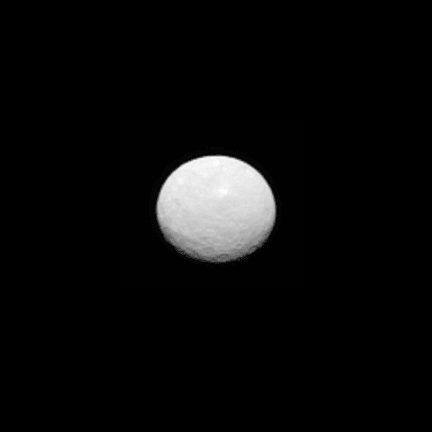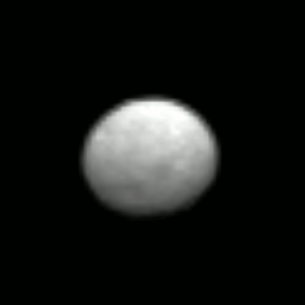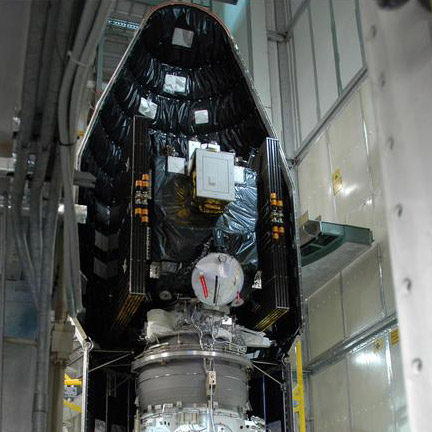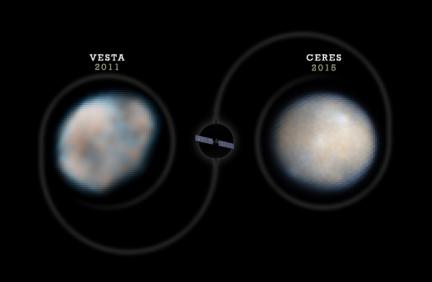Occator Crater is the mesa or large butte with a flat top located in the lower right hand corner of the image. It has been puzzling scientists since Dawn approached Ceres because its brightness was so intense that people were speculating if light could somehow actually be emanating from within the body. Many details are now visible in the boundaries between the bright and dark material but it is not yet clear if the lines are runoff, splatter or some other process yet to be understood.
Ceres: The Center of Occator Crater
We missed this amazing image (March of 2016) of the enigmatic Occator Crater on Ceres by the Dawn spacecraft. Scientists studying Ceres’ bright spots determined the spots’ age are only about four million years, some 30 million years younger than Occator crater itself. This suggests that there have been eruptive outbursts of sub-surface salt-water on Ceres over a long period of time and could even still be happening today.
That is an amazing discovery considering that the size of Ceres is smaller than anyone would have expected to have the ability to generate internal heating enough to create such processes.
Original image posted by JPL.
Ceres Bright Spots Still Unknown
 Still — as close as this is, the nature of these spots are unknown. Must… get… closer… Read more.
Still — as close as this is, the nature of these spots are unknown. Must… get… closer… Read more.
Ceres Bright Spots
 New images of Ceres show the bright spots as a series of smaller spots in close proximity. This makes it fairly certain that the source is a highly reflective surface — such as ice.
New images of Ceres show the bright spots as a series of smaller spots in close proximity. This makes it fairly certain that the source is a highly reflective surface — such as ice.
Uh, That’s No Asteroid?
Ceres: Several White Spots
 There are now several white spots appearing on Ceres as Dawn makes it’s final approach to the dwarf planet. Any knee-jerk expectation say that there is merely a brighter material beneath the surface that was revealed by ancient impacts. Why the surface is darker and the underneath material is brighter (see Iapetus) would be a mystery… but perhaps they still may be related to the active geysers scientists have previously predicted due to data provided by The Herschel Infrared Space Observatory.
There are now several white spots appearing on Ceres as Dawn makes it’s final approach to the dwarf planet. Any knee-jerk expectation say that there is merely a brighter material beneath the surface that was revealed by ancient impacts. Why the surface is darker and the underneath material is brighter (see Iapetus) would be a mystery… but perhaps they still may be related to the active geysers scientists have previously predicted due to data provided by The Herschel Infrared Space Observatory.
We shall soon see.
Dawn Begins Observations
 The Dawn spacecraft is approaching Ceres and has begun observations, including this first animation. Ceres is a dwarf planet that resides within the Asteroid Belt between Mars and Jupiter and is the last unexplored spherical body (that we know of) that resides within the orbit of Neptune.
The Dawn spacecraft is approaching Ceres and has begun observations, including this first animation. Ceres is a dwarf planet that resides within the Asteroid Belt between Mars and Jupiter and is the last unexplored spherical body (that we know of) that resides within the orbit of Neptune.
Earlier observations by the Herschel Infrared Space Observatory have suggested the presence of water vapor in the form of plumes near the surface of Ceres. There is even the chance that this comparatively tiny body may somehow maintain a tenuous atmosphere. If any of this turns out to be the case, we currently have no models to suggest how geological activity could be generated on such a small world. We have known for a very long time that internal heating and geological activity is common on bodies whose mass is large enough to create their own internal furnaces (Earth, Venus and gas giants like Jupiter). More recently we have discovered smaller geologically active worlds that generate internal heat from tidal forces inflicted by their host planet and neighboring moons (Io, Enceladus, probably Triton). But we have never seen such a small isolated body such as Ceres manage to do anything but display ancient craters and fracturing from cataclysms dating back to the formation of the solar system.
Logic tells me to expect to see a grey cratered ball when Dawn goes into orbit around Ceres this Spring, but the experience of Voyager and Cassini tells me not to expect anything but the unexpected.
Also, what is that bright dot? It has been in every image of Ceres since Hubble started observations to support the coming encounter.
Carnival of Space Is Nearly Here
I have been contacting some of my favorite space related bloggers about their potential inclusion in the upcoming Carnival of Space to be hosted here at Wandering Space on Sept. 27. Many of these individuals surprised me by admitting that they hadn’t been aware to its existence. So, in case you are unfamiliar… The Carnival of Space is simply a regular round-up of posts relating to space exploration and research. Each issue of the carnival is hosted at a different blog location and the editor of said blog would, in effect, curate that edition of the carnival. The final result is essentially just a blog post that links out to several other blogs posts and hopefully works as a sort of “best of” collection for the past few weeks. It is a great opportunity to get a whole lot of traffic as a host and share that traffic with other bloggers by linking to their individual posts. The hope is that it will not only get people reading a single article, but maybe stay a while and check out the rest of the blog… maybe even become a regular reader or subscriber.
The last edition of the Carnival of Space (#21) was hosted at whyhomeschool.blogspot.com. That edition had a theme which was the unveiling of the Google Lunar XPrize. Like that edition, the next edition to be hosted here will have a theme of “Art and Imagery of Space”. Hopefully highlighting both people who creativly work with space imagery, as well as people who do more technical compositing and work with mission data. If you have any ideas or potential content for the next carnival please contact wanderingspace.net with your ideas. Only three days left.

Coincidentally, The Dawn Mission to the Vesta and Ceres (asteroids) is scheduled to lift-off the same day as the carnival. This has been repeatedly delayed for a while now. Hopefully the 27th sticks.
Dawn: Dual Mission to Vesta and Ceres
The Dawn mission to the 2 largest asteroids in our Solar System was supposed to have been launched this week, but has been postponed until September of this same year. Apparently due to Dawn’s repeated launching schedule delays it could have interrupted the launching schedule for the Mars Pheonix lander which has a less flexible launch window.

The above images are the best taken thus far of both objects by the Hubble Space Telescope (images not to scale). Vesta appears to be similar to most objects of its type with one exception... We most likely have samples of this body here on Earth as meteorites. It seems the composition of a bunch of meteors known as HED class meteors match that of observations made of Vesta. The theory is that at some point a huge impact took place on Vesta which shattered it into many fragments. Some of these Vesta originating fragments are orbiting the sun in the Asteroid belt to this day while smaller bits of this collision were thrown inward toward the sun (likely through disturbances coming from Jupiter) and some wound up landing here on Earth as meteors. If this turns out to be true, then Vesta would be one of only 5 bodies that we currently have confirmed samples of. Those additional bodies being our own moon, Mars (also through a similar natural meteoric process), Wild 2 and Earth itself.
Ceres on the other hand is the largest Asteroid in the Solar System and for a few days was considered a planet in 2006 until the definition of “planet” was fine tuned a few days later to exclude not only Ceres, but famously Pluto as well. However, an upgrade was in order and Ceres is now officially a Dwarf Planet as it maintains its own spherical shape, orbits the Sun and is not itself a moon of any other body. More interesting than its definitive status in the Solar System is the fact that it is relatively warm, may have a tenuous atmosphere and frost on the surface. Some surface features have also raised many questions about the nature of Ceres such as the dark spot that was imaged in 95 and later disappeared. Then there is the recently observed white spot which has no theoretical identity at all. Hopefully, this may mean that in 2015 we may discover that Ceres is not just another heavily cratered inactive grey body in our Solar System but another enigmatic body like Io and Enceladus that defies preconceived notions of what to expect. Who knows what processes might cause Ceres to be active on any level, but surely we have been surprised before.


